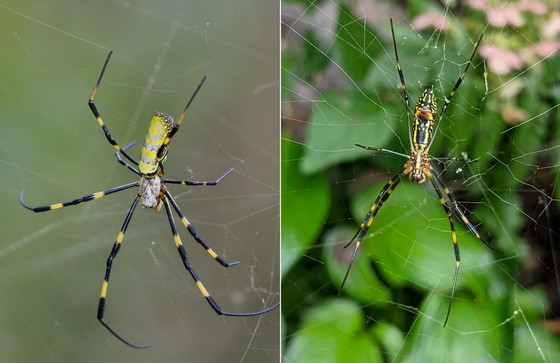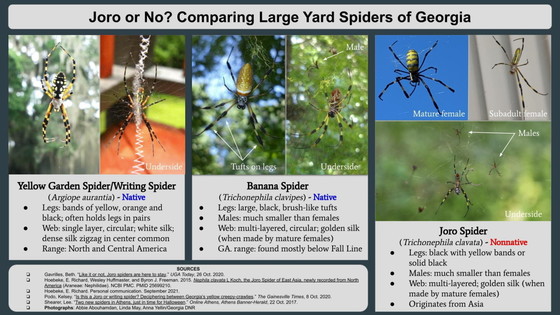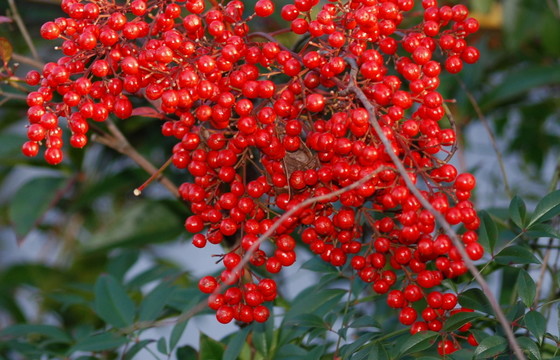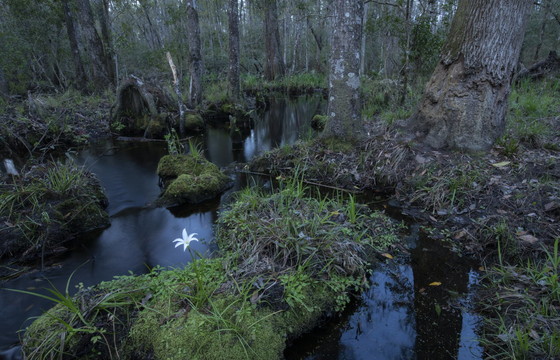IN THIS ISSUE
- Spotting spiders
- Nandina's downfall
- Cottonmouth combat
- Buy a license, help wildlife
 Dorsal (left) and ventral views of female Joros (left, Anna Yellin/DNR; Abbie Abouhamdan/DNR)
By ANNA YELLIN
Considering the numbers of Joro spiders around this year, northeast Georgians might not need to add decorations for Halloween.
The big East Asian spiders, first documented in North America eight years ago in north Georgia, have spread across the region (“Spider weaves way,” Oct. 27).
But early fall is also when native spiders are often more obvious around the yard. Why? And what, if anything, should you do if you find a Joro?
First, according to entomologist Richard Hoebeke of the Georgia Museum of Natural History there are several reasons why you are seeing more webs this time of year.
Some spiders, including many orb-weavers, are nocturnal. Shorter days mean more time to spin and tend webs. Fall is also when spiders are full-grown – it’s their breeding season – and they build larger webs with stronger silk. Bigger webs catch more insects, which especially benefits females, which need to eat more to produce thousands of eggs.
As for Joros, their impact on native invertebrate communities is not known yet. Some scientists think they are out-competing native spiders. Hoebeke, associate curator of insects at the University of Georgia museum, believes there are so many Joros that homeowners killing them will not stem the invasion.
Yet while that view sounds sobering, Hoebeke is not pessimistic. He believes the insect community will reach a natural balance as more species recognize Joros as a threat and a resource. For example, he has noticed that mud daubers have discovered the newcomers are excellent food for the wasps' developing offspring.
Trying to tell if a spider is a Joro or not? Click the guide below for a closer look.
 (Created by Abbie Abouhamdan, DNR GIS specialist)
 Nandina berries.(Terry W. Johnson)
By TERRY W. JOHNSON
Nandina's history in North America spans more than two centuries. The popular ornamental reached our shores in 1804, an export from the Orient deemed suitable for the New World.
This plant also known as heavenly or Chinese bamboo seemed ideal. Hardy and able to grow in wet and dry soils, it sported dark green foliage and bright red berries that hung on through winter, adding color to an otherwise dull landscape.
Wildlife and garden experts even touted nandina as a valuable wildlife food plant. The persistent berries provided much-needed food for birds during a season when food is scarce.
But in the 1960s, the plant's stellar patina began to crack. First came the news that nandina was escaping yards and invading wild lands. Then, amid reports of birds dying, scientists discovered that heavenly bamboo had an ever darker side …
Read more about nandina’s fall from grace, including alternatives for your yard.
Terry W. Johnson is a retired DNR program manager and executive director of TERN, the Wildlife Conservation Section’s friends group. Check out past columns, his Backyard Wildlife Connection blog and his book “A Journey of Discovery: Monroe County Outdoors.” Permission is required to reprint his columns.
 Moccasin males about to tangle (Matthew Moore/DNR)
Walking up on two big cottonmouths fighting in a creek would cause many people to walk away. For Statesboro’s Matthew Moore, however, the recent encounter in a Bulloch County swamp offered the welcomed chance to watch and video the male-on-male combat of these iconic snakes.
Moore said that while most snakes mate in spring, the prime time for cottonmouths and other pit vipers is late summer through early fall. That’s when males vying for females tangle in dance-like tussles, intertwining, rising up to gain advantage and trying repeatedly to push the other snake down.
“It’s basically a wrestling match for the rights to mate with a local female,” Moore explained. The venomous snakes don’t bite each other, he added, and losers escape humbled but unhurt.
Moore, a DNR wildlife technician who has a way with water moccasins (“Cottonmouth encounter,” May 2017), has seen three such fights. One lasted less than 60 seconds, the other almost 30 minutes. The latest paired cottonmouths each measuring about 3 1/2 feet long and included at least three rounds.
In this video, the winner of a skirmish just downstream finds the second cottonmouth resting near a cypress tree, which is also where Moore is hiding. The moccasins grapple again. The outcome is the same. The dominant male chases the slightly smaller snake away, then seems to lay claim to the creekbank cypress.
Moore suspects a female moccasin was hiding in the roots and tunnels beneath his feet. “I went back the next day and saw the same male laying at the same spot.”
See more of Matthew Moore’s cottonmouth videos, including of this incident.
 Often overlooked in the rush of fall hunting seasons is how hunting and fishing licenses help fund wildlife work.
In Georgia, each license sold – even a one-day $5 combo – returns to the state that license fee plus as much as $45 in federal excise taxes paid by hunters and anglers on gear, ammo and related purchases.
For license buyers, there’s even more. In addition to hunting and fishing privileges, a license offers access to more than 1 million acres of DNR wildlife management and public fishing areas.
When buying a license at gooutdoorsgeorgia.com, users also can easily donate to the Georgia Wildlife Conservation Fund by rounding up a purchase, donating directly or picking the Wild about Georgia package, which bundles a one-day license with a donation. The fund was created by state law to help conserve native wildlife not legally fished for or hunted, plus rare plants and natural habitats.
Whether you like to hunt, fish, watch wildlife or all of the above, buying a license is the best deal for you and wildlife.
More ways to support wildlife conservation in Georgia.
ONLINE CAUTION
Some DNR customers recently received an email from an app that wrongly claimed affiliation with the agency. The only trusted online site to buy a license and find regulations information is gooutdoorsgeorgia.com or the Go Outdoors Georgia app.
 Freshwater wetland at Ceylon (Mac Stone)
Conservation of one of the Eastern Seaboard’s largest and previously unprotected wildlands spurred a celebration at Ceylon Wildlife Management Area this month. The Camden County WMA harbors more than 30 protected wildlife species on 27,000 acres of forest and wetlands ("Wild with promise," June 17, 2020). DNR Commissioner Mark Williams stressed that acquiring, protecting and opening the site for outdoor recreation “would not have been possible without the support and investment of all our dedicated partners.”
New NOAA regulations aimed at reducing the risk of North Atlantic right whales being entangled in commercial fishing gear are drawing fire. Entanglements and vessel strikes are the leading causes of death for the critically endangered whales, which calve off the Georgia/north Florida coast.
Prescribed fire’s impact on Georgia forests, as well as its role in air quality, climate change and restoring wildlife, will be center stage at the Sept. 30 virtual conference of the Georgia Prescribed Fire Council. Register for the free meeting and sign up for field trips planned around the state at garxfire.com.
Let the birding begin! The state's first virtual Youth Birding Competition starts Friday as 30-plus teams statewide try to find the most bird species in a single 24-hour period through Oct. 3, then submit their checklists by email or eBird.
 Snail darter from South Chickamauga Creek (Brett Albanese/DNR)
The snail darter, notorious for stalling construction of Tennessee’s Tellico Dam in the 1970s, has recovered to the point it should be delisted under the Endangered Species Act, the U.S. Fish and Wildlife Service says. In Georgia, the darter is found in South Chickamauga Creek, where monitoring will remain a priority.
Know a Georgia teacher in kindergarten through fifth grade who is known for their energy and innovation in teaching life sciences? Tell them about DNR’s $1,000 Conservation Teacher of the Year grant, offered by the agency’s Wildlife Conservation Section and its friends group TERN. Apply by Oct. 15.
Quick hits:
- A fungal disease that is deadly to snakes and made headlines in 2008, raising alarm as a possible emerging threat, actually has been widespread in the U.S. for 75 years, a review of museum snake specimens shows.
- Pocket gophers glow in the dark, according to research led by Dr. J.T. Pynne, who studied the Georgia mammals – and their biofluorescence – as a doctoral student at UGA (“Not your average rodent,” Feb. 28, 2020).
- Georgia will mark National Hunting and Fishing Day Sept. 25 with kids’ fishing events, an Outdoor Adventure Day at Paradise Public Fishing Area and a free fishing day on public waters – no fishing or trout license needed.
- The COVID-19 surge has moved CoastFest 2021 online, with the Brunswick festival featuring biologist Q&As and other live-stream options Oct. 5-7.
- This year’s native plant sale at the State Botanical Garden of Georgia starts Oct. 7, lasts six days and highlights Georgia Pollinator Plants of the Year.
 DNR's Shan Cammack and prescribed fire crew featured in regional magazine (Southwest Georgia Living)
Names in the news: The latest Southwest Georgia Living features DNR Wildlife Conservation Section Fire Safety Officer Shan Cammack and the agency’s southeast Georgia fire crew in an article about controlled burning at Seminole State Park. DNR game warden 1st Class John Rhodes of Hancock County is the Law Enforcement Division’s Game Warden of the Year. Warden 1st Class Tyler Lewis of Cobb County received the James R. Darnell Award as runner-up. Atlanta Botanical Garden’s Carrie Radcliffe is the new chair of the Bog Learning Network, a group focused on conserving southern Appalachian bogs. The U.S. Forest Service’s Woodsy Owl (“Give a hoot, don’t pollute”) turned 50 on Sept. 15.
WHAT YOU MISSED ...
In the previous Georgia Wild:
- The scoop on spittlebugs
- A fish full of surprises
- Alligator Creek's rare bees
"Southeast’s gray foxes may be struggling for survival," UGA
"Whimbrels crossing tropical storms," Argos
"Feds: new lobster restrictions to protect right whales," WBUR-FM (Boston)
"Warming Atlantic forces right whales into new habitats, danger," Cornell University. Study in Oceanography.
"'Whoop:' New method precisely detects right whale vocalizations," Florida Atlantic University
(+video) "Giant Asian spiders ‘here to stay’ in Southeast," Outdsider.com
"Mussel gets protected habitat thanks to museum collections," Florida Museum of Natural History
(+video) "Sea turtle educates thousands then returns to ocean," UGA Today
"Golden Ray capsized because of inaccurate stability calculations," CNN
"Partners fix roads, habitats in southwest Georgia," U.S. Fish and Wildlife Service
"Kentucky: Man illegally sold box turtles bound for China," Lexington (Ky.) Herald-Leader
"Searching for bird life in former ‘ocean of forest,’" The New York Times
 Urban Wildlife Program frees entangled buck, DNR. Also: WSB-TV (Ch. 2, Atlanta).
Timber rattlers traveling together, DNR. Also: Timber rattlesnake swimming across Lake Allatoona.
"Georgia Wild: Lizards," DNR
TikTok time-lapse of spider building a web, Nerdist
CREDITS
Masthead: northern cottonmouth (Matthew Moore/DNR)
|